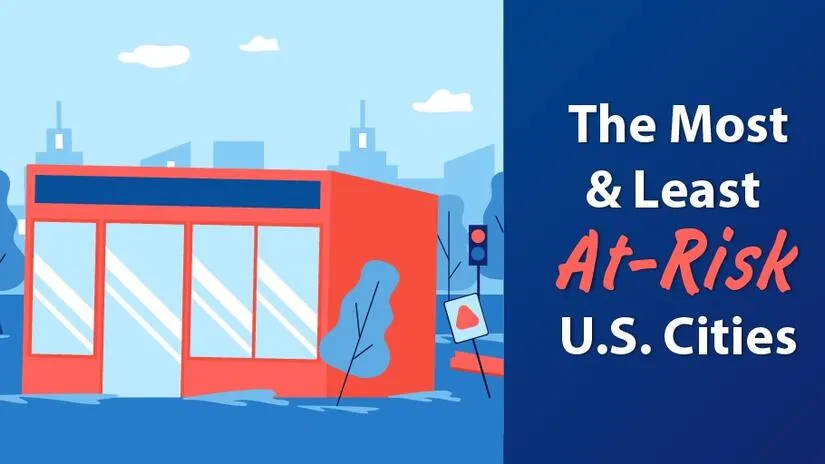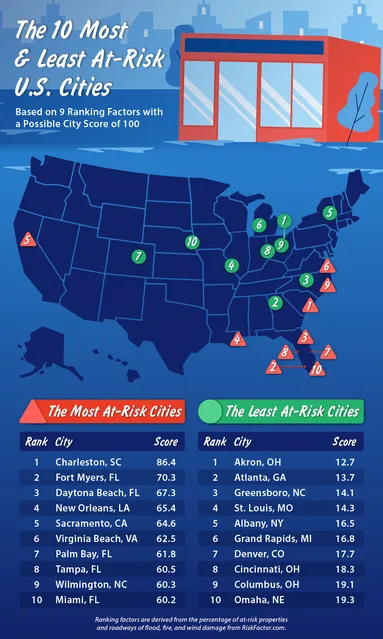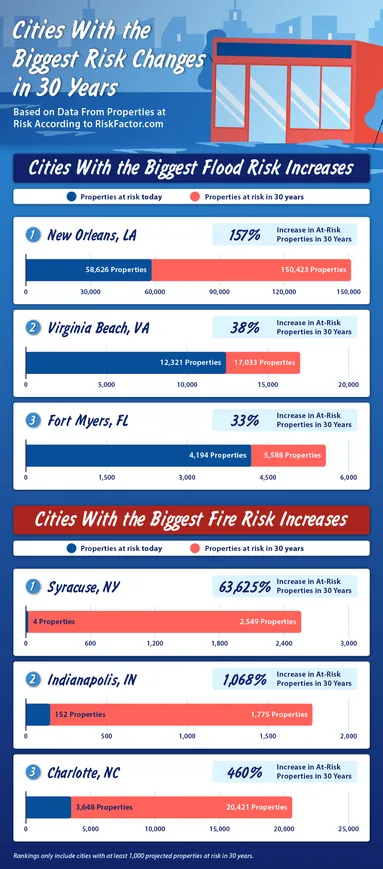
Do you live in a city where the weather seems to have it out for your property? Of course, some cities are just more prone to property damage than others. Whether you expect it or not, Mother Nature is always ready to rumble somewhere.
Floods, fires, heatwaves, wicked winds: these elemental forces don't care what stands in their way, and Americans find themselves at an ever-increasing risk of property damage year after year. To provide some additional insight into which cities are particularly vulnerable, the team at Rainbow Restoration® ranked the 100 most populated cities in the U.S. from 1 to 100 based on flood, fire, heat, and wind risk factors for commercial and residential properties based on data from RiskFactor.com. The team also found out which cities can expect the most significant increases in property damage risk from floods and wildfires over the next 30 years.
If you're a property owner or someone who just wants to be prepared for any scenario, keep reading to find out if your city made the list.
Key Findings
- Charleston, South Carolina, is the city most at risk of property damage in the study, with a risk score of 86.4 out of 100.
- Florida is home to five of the most at-risk U.S. cities, including Fort Myers, Daytona Beach, Palm Bay, Tampa, and Miami.
- Three Ohio cities are in the top 10 for the least at-risk, including Akron, Cincinnati, and Columbus. Akron is the least at-risk city for property damage in the study with a risk score of 12.7 out of 100.
The 10 Most & Least At-Risk U.S. Cities

In Charleston, South Carolina, 65% of residential properties, 79% of commercial properties, and 73% of road miles are in danger of flooding. But that’s not all. A mind-boggling 95% of residential properties are at risk of being scorched by wildfires, earning Charleston the top spot on our most at-risk list. The risk of residential property damage in Charleston gave it the top spot in our ranking.
Charleston isn't alone in its battle against the elements. Living with risk is an everyday reality for Fort Myers, Florida, business owners. For example, 46% of commercial properties in the area face flood risk, while 60% are at fire risk. Those are odds no business owner should take lightly.
Behind its picturesque façade, the coastal city of Daytona Beach, Florida, faces a severe flooding problem. According to our data, nearly 40% of residential and 55% of commercial properties in the area are at risk. The city experienced several severe weather events in recent years, including Tropical Storm Nicole and Hurricane Ian in 2022.
Least At-Risk
When it comes to natural disasters, some cities have all the luck. Only 5% of residential properties and 18% of commercial properties in Akron, Ohio, face flooding risk, and zero percent of both residential and commercial properties are at risk of wildfire. In our study, this makes Akron the least likely city to sustain commercial or home damage from a natural disaster or other severe weather events.
Atlanta, Georgia, might not be as lucky as Akron, but it's still doing pretty well. With only 20% of its road miles at risk of flooding, the city is far below the national average of 35%. And when it comes to wildfires, residential and commercial properties in Atlanta face no risk. That's peace of mind you can't put a price on.
The landlocked city of Greensboro, North Carolina, not only boasts the lowest percentage of commercial properties at flood risk among all the cities we analyzed (just 6%!), but only 3% of commercial properties face wildfire risks. The only catch? 14% of Greensboro's road miles are at risk of flooding. But hey, you can't have it all, right?
What Risk Could Look Like in 30 Years
New Orleans, Louisiana, is no stranger to natural disasters. Hurricane Katrina (2005) remains the most costly hurricane in U.S. history ($190B, according to NOAA). Unfortunately, the city's flood woes are far from over. Despite having 38 adaptation measures in place that protect over 500,000 properties, there are still almost 59,000 properties at risk of flood damage. That number is projected to grow to over 150,000 in the next 30 years, which is by far the most significant jump in the study.
By 2053, the number of Virginia Beach, Virginia, properties at flood risk will increase by an unsettling 38% (from about 12,300 to just over 17,000), highlighting the need for improved city-level infrastructure and planning.
Appearing for the second time in our study, we have this Florida city. The expectation is that Fort Myers, Florida, will show a 33% increase in properties at risk of flood damage. Currently, 4,200 properties stand at risk, and our study shows that number reaching 5,500 over the next 3 decades. While this is a less significant increase compared with the other cities mentioned above, it still represents a substantial jump in the risk levels facing this city.
Fire Risk
In a region where very few properties stand at risk today, our study unveiled skyrocketing wildfire risk in the coming years. Only four properties in Syracuse, New York, meet the wildfire risk criteria to date, but by 2053, that number is expected to exceed 2,500. Compared to the tens of thousands of homes and businesses in Syracuse, it's a small number, but it highlights an alarming trend facing cities nationwide.
One such city is Indianapolis, Indiana. At present, about 150 properties are at risk, but within the next 30 years, the expectation is that the number will reach 1,800. That's an eye-opening 1,068% increase! This rapid escalation emphasizes the importance of preparing for and mitigating the risk of wildfires in the area.
With an expected 460% increase in properties at risk over the next three decades, Charlotte, North Carolina, is no exception to the rapidly changing risk levels across America. Over the next 30 years, the city could see a jump from approximately 3,600 properties at risk to over 20,000. These findings underscore the need for policymakers and residents to take urgent action to safeguard their communities against the devastating impact of wildfires.
All Risk Factors Considered
Ready to dive into our comprehensive data set to see how your city stacks up against the rest? We created this sortable data table to help you make informed investment and adaptation decisions for the future.
Closing Thoughts
Understanding U.S. cities' risks is crucial in making informed decisions and preparing for the future. As the impact of climate change is felt nationwide, it's essential to stay informed, prioritize safety measures, and support policies that protect our communities.
When natural disasters, like floods and fires, strike, they can leave property owners frustrated and with a sense of urgency to get back up and running as soon as possible. At Rainbow Restoration, we’re here to ease some of that burden with a full suite of residential and commercial restoration services to help you get your business and property back on track so you can breathe easily.
Methodology
To find the most at-risk cities for property damage, we started with a list of the 100 most populated cities in the U.S. and ranked them from 1 to 100 based on flood, fire, heat, and wind risk factors from RiskFactor.com.
We then assigned weights to each factor depending on how much they could affect property owners. Based on the weights, each city we analyzed was given a score out of 100. Using projections from RiskFactor.com, we were also able to find the cities that could see the most significant increases in property damage from flood and fire over the next 30 years.

